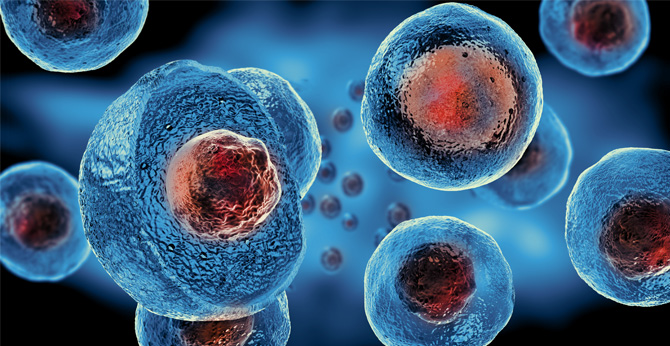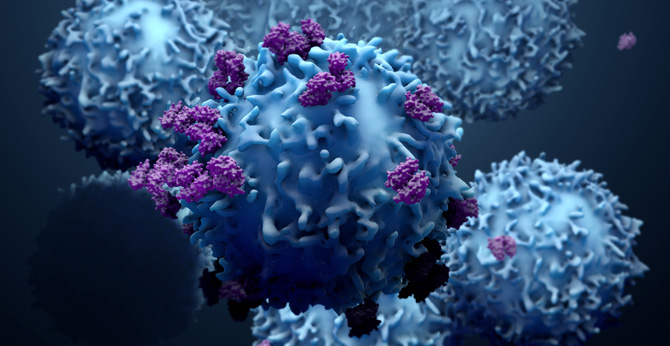All products and services are For Research Use Only and CANNOT be used in the treatment or diagnosis of disease.
Blew is our CD86 CAR related products. Please refer to the list provided to locate the products for your needs.
Primarily expressed on antigen-presenting cells (APCs), cluster of differentiation 86 (CD86) plays an important role in the immune response. It is a promising target for CART therapy due to its selective expression on APCs, its role in T cell activation, and its potential to enhance the anti-tumor immune response.
We are pleased to provide anti-CD86 CAR expression analysis. Our comprehensive service aims to accurately evaluate the expression levels and functionality of anti-CD86 CAR in various research settings. The analysis includes the assessment of CAR surface expression on target cells, quantification of CAR expression using flow cytometry or other applicable methods.
CD86 CAR-T Cytokine Release Test
Our release test measures the level of cytokines released by CD86 CAR-T cells when they are activated, providing insights into their potential to cause cytokine release syndrome (CRS).
 Fig.1 Secretion of IFNγ or IL-2.1
Fig.1 Secretion of IFNγ or IL-2.1
CD86 CAR-T In Vitro Cytotoxicity Assay
Our highly skilled team of scientists and technicians is experienced in performing this assay using a variety of target cell lines and experimental conditions. We will tailor the assay design to meet your specific research needs and provide you with reliable and reproducible results. By availing of our CD86 CAR-T cell in vitro cytotoxicity assay service, you can accelerate your research and development efforts, saving time and resources. Our commitment to quality and scientific excellence ensures that you will receive reliable data to support your scientific objectives and make informed decisions.
 Fig.2 Cytotoxicity analysis of CD86 CART and other CARTs.1
Fig.2 Cytotoxicity analysis of CD86 CART and other CARTs.1
CD86 CAR-T Cell Proliferation Test
Our team of highly skilled scientists and researchers work diligently to perform the CD86 CAR-T cell proliferation test with the utmost precision and attention to detail. Using state-of-the-art equipment and advanced methodologies, we measure the expansion and growth of CD86 CAR-T cells in response to specific stimuli or antigens.
 Fig. 3 CD86 CART efficiently lysed all six AML cell lines.1
Fig. 3 CD86 CART efficiently lysed all six AML cell lines.1
CD86 CAR-T Cell Therapy Animal Models
Animal models provide you with an invaluable tool to evaluate the efficacy and safety of your CD86 CAR-T cell therapy candidates. Our models allow for the assessment of various parameters such as tumor regression, immune cell infiltration, cytokine production, and overall survival. We aim to accelerate the development of novel therapeutics and empower our clients to make informed decisions regarding CD86 CAR-T cell therapy candidates.
 Fig.4 Anti-CD86 CART exhibited high potency in AML xenograft models.1
Fig.4 Anti-CD86 CART exhibited high potency in AML xenograft models.1
Using cutting-edge technology and advanced imaging techniques, we provide detailed data on the therapeutic potential and anti-tumor activity of CD86 CAR-T cells. Our customers will gain valuable insights into the effectiveness of your therapy and make informed decisions regarding its development and future applications. Our team is committed to delivering high-quality data and timely results to support the advancement of CD86 CAR-T cell therapies in the fight against cancer.
 Fig.5 CD86 CART can eliminate Mv4-11 tumor burden in vivo.1
Fig.5 CD86 CART can eliminate Mv4-11 tumor burden in vivo.1
Toxicity Evaluation of CD86 CAR-T
We are pleased to offer the CD86 CAR-T cell toxicity evaluation service, which aims to assess the potential toxicity of CD86 CAR-T cell therapy. By performing these comprehensive evaluations, we will provide valuable data on the potential toxicity of CD86 CAR-T cell therapy.
contact us today and let us know how to assist you in your research and development endeavors.
Reference
 Loading...
Loading...
| CAT | Product Name | Target Species | Antibody Clone | Antibody Host | Receptor Construction | Vector Type | Targeting Cell Type | CAR Vector Type | Inquiry & Datasheet |
| CAR-0120ZP895 | Anti-CD86 (PG140) h(CD28-CD3ζ) CAR, pCDCAR1 | Human | PG140 | Human | scFv-CD28-CD3ζ | Lentiviral vector | T Cell | ||
| CAR-0120ZP896 | Anti-CD86 (PG140) h(4-1BB-CD3ζ) CAR, pCDCAR1 | Human | PG140 | Human | scFv-4-1BB-CD3ζ | Lentiviral vector | T Cell | ||
| CAR-0120ZP899 | Anti-CD86 (Fun1) h(CD28-CD3ζ) CAR, pCDCAR1 | Human | Fun1 | Mouse | scFv-CD28-CD3ζ | Lentiviral vector | T Cell | ||
| CAR-0120ZP900 | Anti-CD86 (Fun1) h(4-1BB-CD3ζ) CAR, pCDCAR1 | Human | Fun1 | Mouse | scFv-4-1BB-CD3ζ | Lentiviral vector | T Cell | ||
| CAR-0120ZP901 | Anti-CD86 (IT2.2) h(CD28-CD3ζ) CAR, pCDCAR1 | Human | IT2.2 | Mouse | scFv-CD28-CD3ζ | Lentiviral vector | T Cell | ||
| CAR-0120ZP902 | Anti-CD86 (IT2.2) h(4-1BB-CD3ζ) CAR, pCDCAR1 | Human | IT2.2 | Mouse | scFv-4-1BB-CD3ζ | Lentiviral vector | T Cell | ||
| CAR-0120ZP903 | Anti-CD86 (MM0101-7F35) h(CD28-CD3ζ) CAR, pCDCAR1 | Human | MM0101-7F35 | Mouse | scFv-CD28-CD3ζ | Lentiviral vector | T Cell | ||
| CAR-0120ZP910 | Anti-CD86 (GL-1) h(4-1BB-CD3ζ) CAR, pCDCAR1 | Human | GL-1 | Rat | scFv-4-1BB-CD3ζ | Lentiviral vector | T Cell | ||
| CAR-0120ZP911 | Anti-CD86 (2D10) h(CD28-CD3ζ) CAR, pCDCAR1 | Human | 2D10 | Rat | scFv-CD28-CD3ζ | Lentiviral vector | T Cell | ||
| CAR-0120ZP919 | Anti-CD86 (E2G8P) h(CD28-CD3ζ) CAR, pCDCAR1 | Human | E2G8P | Rabbit | scFv-CD28-CD3ζ | Lentiviral vector | T Cell | ||
| CAR-0120ZP920 | Anti-CD86 (E2G8P) h(4-1BB-CD3ζ) CAR, pCDCAR1 | Human | E2G8P | Rabbit | scFv-4-1BB-CD3ζ | Lentiviral vector | T Cell | ||
| CAR-0120ZP921 | Anti-CD86 (4H4) h(CD28-CD3ζ) CAR, pCDCAR1 | Human | 4H4 | Rat | scFv-CD28-CD3ζ | Lentiviral vector | T Cell | ||
| CAR-0120ZP922 | Anti-CD86 (4H4) h(4-1BB-CD3ζ) CAR, pCDCAR1 | Human | 4H4 | Rat | scFv-4-1BB-CD3ζ | Lentiviral vector | T Cell | ||
| CAR-0120ZP923 | Anti-CD86 (4G3) h(CD28-CD3ζ) CAR, pCDCAR1 | Human | 4G3 | Mouse | scFv-CD28-CD3ζ | Lentiviral vector | T Cell | ||
| CAR-0120ZP924 | Anti-CD86 (4G3) h(4-1BB-CD3ζ) CAR, pCDCAR1 | Human | 4G3 | Mouse | scFv-4-1BB-CD3ζ | Lentiviral vector | T Cell | ||
| CAR-0120ZP925 | Anti-CD86 (4F12) h(CD28-CD3ζ) CAR, pCDCAR1 | Human | 4F12 | Mouse | scFv-CD28-CD3ζ | Lentiviral vector | T Cell | ||
| CAR-0120ZP926 | Anti-CD86 (4F12) h(4-1BB-CD3ζ) CAR, pCDCAR1 | Human | 4F12 | Mouse | scFv-4-1BB-CD3ζ | Lentiviral vector | T Cell | ||
| CAR-0120ZP929 | Anti-CD86 (3F3) h(CD28-CD3ζ) CAR, pCDCAR1 | Human | 3F3 | Mouse | scFv-CD28-CD3ζ | Lentiviral vector | T Cell | ||
| CAR-0120ZP983 | Anti-CD86 (3D7) h(CD28-CD3ζ) CAR, pCDCAR1 | Human | 3D7 | Mouse | scFv-CD28-CD3ζ | Lentiviral vector | T Cell | ||
| CAR-0120ZP986 | Anti-CD86 (3B8) h(4-1BB-CD3ζ) CAR, pCDCAR1 | Human | 3B8 | Mouse | scFv-4-1BB-CD3ζ | Lentiviral vector | T Cell |
 NEWSLETTER
NEWSLETTER
The latest newsletter to introduce the latest breaking information, our site updates, field and other scientific news, important events, and insights from industry leaders
LEARN MORE NEWSLETTER NEW SOLUTION
NEW SOLUTION
CellRapeutics™ In Vivo Cell Engineering: One-stop in vivo T/B/NK cell and macrophage engineering services covering vectors construction to function verification.
LEARN MORE SOLUTION NOVEL TECHNOLOGY
NOVEL TECHNOLOGY
Silence™ CAR-T Cell: A novel platform to enhance CAR-T cell immunotherapy by combining RNAi technology to suppress genes that may impede CAR functionality.
LEARN MORE NOVEL TECHNOLOGY NEW SOLUTION
NEW SOLUTION
Canine CAR-T Therapy Development: From early target discovery, CAR design and construction, cell culture, and transfection, to in vitro and in vivo function validation.
LEARN MORE SOLUTION